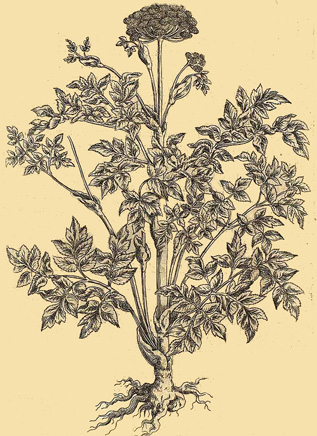|
This wild version of European angelica has as many magical uses as its European cousin. The Iroquois used this magic herb as witchcraft medicine, making a wash from bruised roots to remove ghosts from the house. The Eskimo made the stems into a purifying incense for the inside and outside of the home, and the purification aspect apparently also came into play in Blackfoot medicine societies, where it was a tool for augmenting collective power and an implement in society initiations. The Pomo carried it or hung it in the home for protection. The Karok people purified themselves with the root after attending a funeral. In Mexico folk magic, for instance, if a girl has been frightened, she carries an angelica root for protection in a white bag. Diviners of the Blackfoot tribe utilized the root to increase their power but also to bless other people with a long life and good luck. Wild angelica also functioned as a gambling charm amongst the Blackfoot, either being held in the hand or mouth or tied to the bridle of a horse in racing. The Mendocino likewise carried it as a gambling charm. Kwakiutl Indians tied a bit on their fishing hook for fishing luck, and Lolahnkok Indian fellows rubbed some of the plant on the neck and hands of a young woman to get her to say yes. :) The Delaware sometimes mixed the seeds of angelica with tobacco to sweeten the smoke, so consider it for magical smokes for honoring friendly goddesses or for inclusion in incense for luck, protection, or purification. The fresh stalks taste like a combination of celery and licorice and were candied by European settlers just like European angelica. However, the root of wild angelica should always be dried before use, because it has a bitter component that is probably toxic; drying destroys that. This native of northeastern North America is also known as American angelica, great angelica, high angelica, purple angelica, and masterwort (which is actually another plant). Top
The wild angelica needs cold-warm-cold to germinate, which you can do artificially. Wet a paper towel with a dilute solution of liquid kelp and wring out (some people like to use moist, clean sand instead). Sprinkle the seeds in and fold closed, pressing gently to create a good contact between the seeds and the paper towel. Put in a thin plastic baggie, just folding the top closed and not zipping it. Refrigerate for 2-3 months. Then take out and keep in warmth (not sun) of about 80F for 2-3 months. Then back into the refrigerator for another 2-3 months. Then take out and tear the paper towel up, gently pressing pieces with seeds facing down onto the top of a moist planting medium. Don't cover with dirt, because the seeds need light to germinate. Or you can skip all this and plant in a pot outside in fall to germinate in two years. In that case, cover the seeds with a thin (1/4") layer of chick grit (finely ground granite used for chicks--you can find this at a feed store or places like Tractor Supply in spring). Cover the top of the pot with a piece of screen to keep the seeds from being eaten by birds and mice. Like many Venus herbs (think mints), wild angelica likes watery places. The stems are purple instead of the green of European angelica. Transplant to full sun or partial shade and a moist, rich soil. It gets 3-8ft/ tall and is a perennial (in contrast to the European angelica, which is biennial). The lower leaves can get a long as your forearm. Umbels of the tiny greenish white flowers can be up to a handslength across. Various types of bees like the flowers, and the caterpillars of the black swallowtail butterly like to eat the leaves. Ripe seeds are brown. Roots must be dried before use. Dry in a dehydrator on the lowest setting, and if the root is thick, slice it up or it will dry only on the outside and the inside will rot. Slice especially thinly and dry for use in incense or a smoke. General growing Top |
Angelica atropurpurea
Protection © 2016-2024 Alchemy Works. No reproduction without permission. |
|
|
|
Alchemy Works products are offered for use in spiritual, ritual, meditative, and magical practices, not for medicinal or cosmetic purposes. The information on this website is provided for its folkloric, historic, and magical value. It is not intended to be a substitute for professional medical advice, diagnosis, or treatment.
 Angelica atropurpurea
Angelica atropurpurea How
to Grow Wild Angelica
How
to Grow Wild Angelica